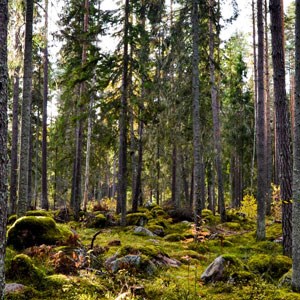Fungi determine carbon dynamics in boreal forest soils

In a new doctoral thesis, Julia Kyaschenko has investigated how fungal communities take part in ecosystem processes in boreal ecosystems by analyzing nutrient cycling and accumulation of organic matter in the soil. The results show that soil fungi are the main drivers of carbon and nitrogen dynamics in boreal forest ecosystems. Therefore, it is vital to include fungi when making models of forest ecosystem.
Boreal forests play an important role in the global carbon cycling, as their soils represent a substantial terrestrial sink for carbon. Fungi are essential in these ecosystems as they are responsible for both decomposition and nutrient cycling.
– In my thesis, I wanted to obtain a better understanding of how fungal communities take part in the regulation of ecosystem processes, such as nutrient cycling and organic matter accumulation, says Julia.
The secrets of the underground revealed with molecular methods
Fungi vary greatly in diversity and functions, and recent advances of molecular methods for species identification allow us to study the entire fungal communities belowground. By investigating fungal activities, for example measuring rates of different enzymes that fungi produce to degrade organic matter, it is possible to get more information on how different species are involved into organic matter decomposition and nutrient cycling.
Here, high throughput sequencing, enzyme assays and stable isotope analyses as well as modelling were used to investigate how fungal diversity and community composition responded to ecosystem fertility and forest harvesting across Sweden.
Certain fungi are very sensitive to forestry
– By studying forest stands ranging from recent clear-cuts to old-growth forests, we found that tree harvesting eliminated mycorrhizal fungi but favored saprotrophic fungi (free-living fungi that obtain C and N from dead organic matter). The effect of this disturbance lasted for at least 50 years, says Julia.
Having short rotational periods in forestry can lead to the disappearance of important functions along with the mycorrhizas fungi, which in turn can lead to a deterioration in forest growth.
Important below ground processes
– We found that within soil profiles, carbon and nitrogen dynamics were highly related to ecosystem fertility, root decomposition and fungal community composition. The belowground processer are more important in long-term humus build-up compared to above-ground litter, says Julia.
The results collected across different scales and ecosystem types underlined soil fungi as the principal drivers of carbon and nitrogen dynamics in boreal forest ecosystems.
– Our results really show that is it important to include soil fungi when you model forest ecosystems, concludes Julia.
Julia Kyaschenko will defend her thesis ”Fungal communities as determinants of carbon dynamics in boreal forest soils” on the 16th of March at 9am. Professor Tom Bruns from the Department of Plant and Microbial Biology at the University of California at Berkeley in USA will be opponent.
Links:
Read the whole thesis here: https://pub.epsilon.slu.se/15304/.